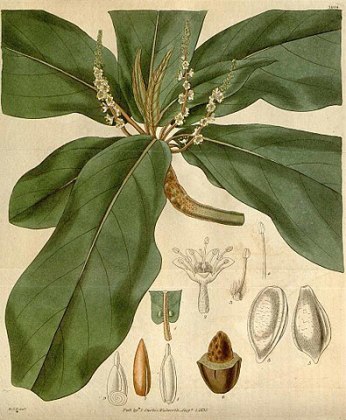In this post I will be looking at a piece of sinister lore surrounding the Almond Tree (Terminalia catappa). This tree, also known as the Indian Almond, Tropical Almond and Sea Almond, introduced into Jamaica in the 1790s, is a tall, large-leafed tree with spreading branches providing lots of shade (“Some Common Trees of Jamaica”, p. 80).
I think Terminalia catappa is the type of almond tree to which Zora Neale Hurston referred to in Tell My Horse: Voodoo and Life in Haiti and Jamaica (1938). Hurston was told by the medicine man (unnamed by Hurston) of the Accompong Maroons, that Almond Trees were the abodes of duppies and therefore should never be planted near a house. If an Almond Tree was planted in close proximity to a dwelling, there was always a risk that the tree’s duppy inhabitants might “throw heat” on the occupants of the house. The result would be that the latter would become very hot and and/or their heads would swell to a large size. Drinking tea made from Spirit Weed could protect people from such duppy heat attacks (Hurston, p. 25).

Elsewhere in the Americas, John Rashford notes that in Brazil the Terminalia catappa is dedicated to Tempo, one of the inkice (a spirit akin to an orisha) from the pantheon of Angolan-influenced Candomblé (Rashford, p. 319). The African-Jamaican belief that the Almond Tree is a home for duppies and its dedication to a minor deity in Brazil fit in with African ideas of connections between trees and the spirit world. For example, in parts of West Africa the Cotton Tree (Ceiba) was regarded as the abode of entities including duppies and Sasabonsam, a large, human-like creature covered in long red hair.
Next time… I move from a possible duppy habitat to one of the many guises that duppies can take.
Sources
Eric Garraway (ed.), “Some Common Trees of Jamaica”, The Natural History Society of Jamaica: http://naturalhistorysocietyjamaica.org/Some%20Common%20Trees%20of%20Jamaica.pdf <accessed 15.03.21>
Zora Neale Hurston, Tell My Horse: Voodoo and Life in Haiti and Jamaica (reprint, with a new foreword by Ishmael Reed, New York: Harper & Row, 1990, of orig. edn, Philadelphia: J.B. Lippincourt Inc., 1938).
John Rashford, “Candomblé’s Cosmic Tree and Brazil’s Ficus Species” in Voeks and Rashford, African Ethnobotany in the Americas, pp.311-334.
Robert Voeks and John Rashford (eds), African Ethnobotany in the Americas (New York: Springer, 2013).
Image credits: W.J. Hooker, Public domain, via Wikimedia Commons: https://commons.wikimedia.org/wiki/File:Terminalia_catappa_illustration.jpg